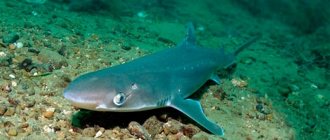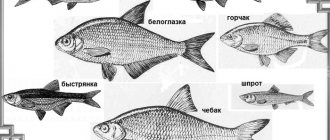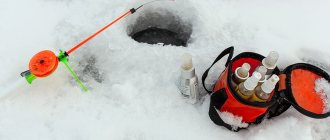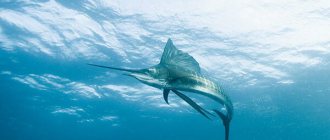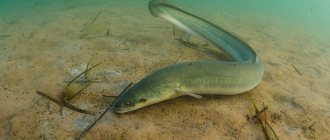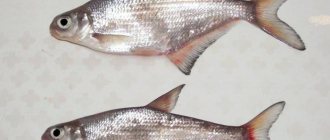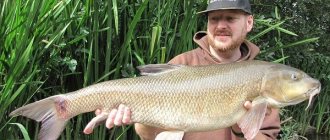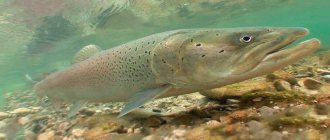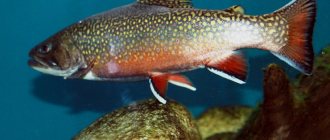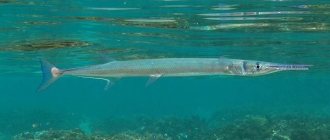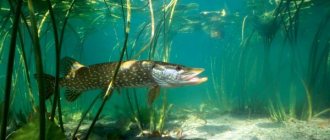Every fisherman dreams of catching a big fish. However, some small representatives of the aquatic world are also good as a trophy. For example, the stickleback fish is quite small, but has unusual and aggressive behavior. Despite its small size, this predator is very voracious, and in case of danger it is able to protect itself from other aquatic inhabitants.
The stickleback fish is quite small, but has unusual and aggressive behavior.
Classification and description of stickleback fish
Based on the type of water, they are divided into freshwater, seawater and anadromous.
The freshwater fish lives and breeds only in fresh water bodies and never enters the sea.
The marine fish lives in the sea and goes to coastal waters to spawn.
The migratory species lives in sea water and breeds in fresh water bodies. If after spawning it does not have time to leave the river, it dies. Newborn individuals gradually move into the sea.
There are several types of smelt, which differ in the number of needles on the back: three-spined, four-spined, nine-spined. In addition, they also include sea stickleback, southern stickleback and brook stickleback.
External characteristics
Stickleback belongs to the ray-finned family of the order Stickleback . The name unites 5 genera and about 8 species of these representatives.
They differ in: spines located in the dorsal fin area. This small fish has no scales, and not all individuals have a ventral fin. Most often, in the fin area there is one spine or 2 soft rays. When danger arises, the sticker uses its weapon, straightening out all the sharp thorns. They pierce the enemy's body.

Stickleback belongs to the ray-finned family of the stickleback order.
There are more than 30 bone plates on the sides of the body. They act as additional protection. The stickleback fish is one of the smallest representatives of water bodies. Body length reaches 5−6 cm in adulthood. Color may vary depending on the species, including:
- four-needle;
- nine-needle;
- stream;
- marine;
- small southern;
- three-needle.
The last one listed is considered the most common. It is distinguished by a brown or greenish tint, and its belly and sides are silvery.
Where does it live?
Especially a lot of stickleback can be found in the Baltic and White Seas. It is found in the rivers of Western Siberia, in the lower reaches of the Dnieper, in the Northern Donets, in the reservoirs of the Black, Azov and Caspian Seas, in the ilmens in the Astrakhan region. Can be found in the Volga and rivers of the Volga basin.
Stickleback fish loves quiet places with calm currents. These can be small grooves, rivers, lakes with a sandy or muddy bottom and banks covered with grass.
Three-spined and nine-spined ones live in all European countries. In Russia, stickleback habitats are rivers flowing into the White and Baltic seas, rivers of the Far East, reservoirs of the Leningrad region, and Lake Onega.
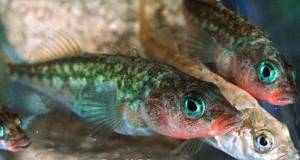
Stickleback lives along the entire coast of Europe, from Norway to the Bay of Biscay. Its habitat is marine areas off rocky shores.
The southern small one is found in desalinated areas of the Azov, Black and Caspian seas, as well as in the rivers that flow into them. Also lives in the lower reaches of the Dnieper and Northern Donets.
Description of stickleback reproduction
Fish spawning time is most often April-May. A few days before this, they change color - they become brighter. Their fertility is low - only 100 eggs laid.
The peculiarity of this species is that the stickleback fish equips a nest for laying eggs. And it is not the female who does this, but the male. He digs a hole in the sand with his mouth, then transfers pieces of silt, algae, grass there and lays out the bottom. For strength, all this is held together by mucus secreted from the sides of the fish. The ball-shaped nest has two holes located opposite each other. Sometimes it is half hidden in the mud and is difficult to detect.
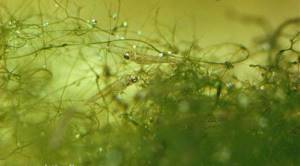
After the place is equipped, the male returns to the flock, selects a female ready for laying and drives her into the nest through one of the holes. The female lays eggs and exits into another hole, after which the male enters the nest and fertilizes the laid eggs with milt.
After this, the male remains at the nest and guards it, keeping enemies away. This continues for about two weeks until all the young fish that have hatched from the eggs leave the nest. And before that, he closely monitors the offspring, not allowing them to go far from the nesting site.
Kinds
The lifestyle and conditions of keeping tetraodons of different species are similar.
Leopard tetraodon (Tetraodon schoutedeni)
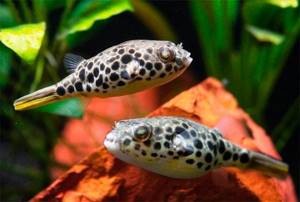
Lives naturally in the lower reaches of the Congo. The sides and back are yellow with black spots. The abdomen is light. In an aquarium it reaches a length of up to 10 cm. They live up to 10 years.
The female is larger than the male. For spawning, the pair is placed in a vessel of 150 liters with plants and shelters. The water temperature is increased to 26–28 °C, and the fish are fed intensively. The female lays up to 250–300 eggs.
Green tetraodon (Tetraodon fluviatilis)
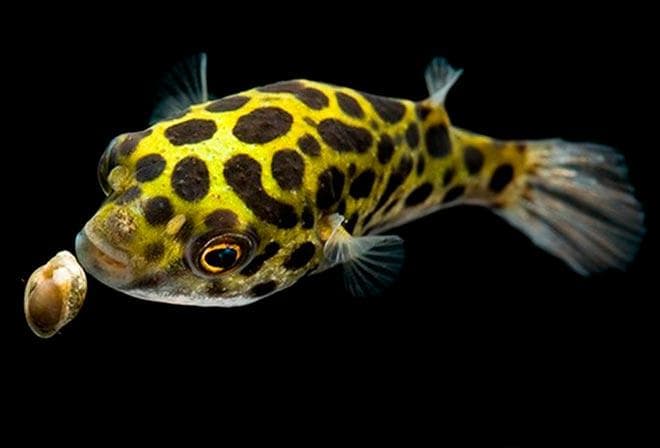
Inhabits brackish standing and flowing water bodies of Southeast Asia. The color of the sides and back is bright yellow with a green tint, with black spots and patterns. The abdomen is white. In an aquarium they grow up to 10–12 cm. They live 8–10 years.
No gender differences were identified. In captivity, for some unknown reason, they do not reproduce.
Dwarf tetraodon (Carinotetraodon travancoricus)
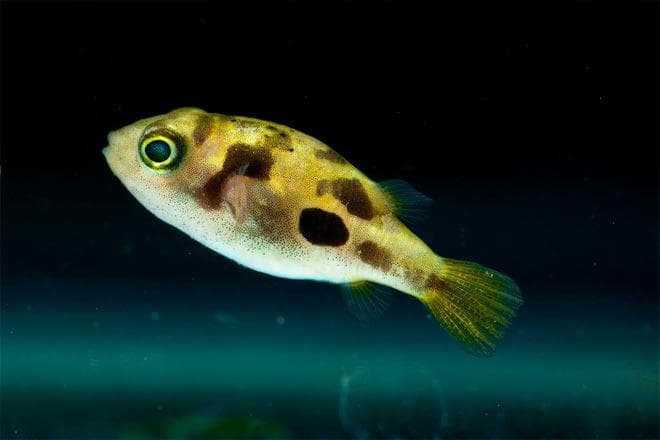
Freshwater fish, lives in standing and flowing waters of southern India. Color ranges from green to yellow-brown. They grow up to 2.5–3.5 cm in length. They live 6–7 years.
It reproduces in the aquarium. In mature males, a dark stripe appears on the abdomen. Females have a rounded abdomen. For splitting into pairs, 6–8 individuals are kept in a species aquarium. For spawning, a pair or harem of males and females is separated. An abundance of plants is necessary. The female willingly lays eggs on mosses. The male, ready for spawning, acquires a contrasting color.
The female lays 8–15 eggs. Caviar from adult fish is isolated. The fry appear after 4–6 days. They are fed with “live dust”, a microworm. Top dressing - mashed hard-boiled egg yolk. After 30–45 days - chopped live and frozen food, brine shrimp.
Nutrition
Stickleback fish eat a wide variety of foods. These are mainly small inhabitants of reservoirs, namely crustaceans, worms, insect larvae, plankton, benthos (organisms living at the bottom of a reservoir). In addition, they are able to eat eggs and young individuals of other fish and even their own species.
They hunt moving prey at night. Hunting is especially successful during the full moon, since they require at least a small amount of light. The stickleback is very active and chases small fish. Having discovered the prey, it rushes towards it, quickly grabs it with its jaws, stretching them forward, and closes its sharp teeth, leaving the victim no chance of salvation. Other sticklebacks, seeing such a picture, rush to her in a school in the hope that they, too, will get food.
Natural enemies of ball fish
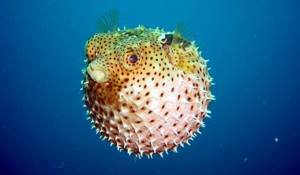
Photo: Fish ball
Thanks to a unique defense mechanism, aggressive nature and desire for a secretive lifestyle, pufferfish have virtually no natural enemies. However, they did not escape the fate of being an element of the food chain thanks to the omnivorous nature of the main predator - humans.
Widely known throughout the world for their poisonous properties, ball fish are, however, one of the main delicacies of Japanese cuisine. Despite the number of deaths that these fish cause to people every year, gourmets continue to eat them.
Up to 60% of people who decide to cook pufferfish themselves, a prominent representative of pufferfish, die from poisoning with its nerve agent.
In Japan, there is a special license issued to chefs who are trained to prepare this deadly dish. As is known, the consumption of fugu liver and ovaries, as they contain the most concentrated poison, is prohibited. To date, there is no antidote for the poison, and victims are given assistance in maintaining the circulatory and respiratory systems until the effects of the poison wear off.
Interestingly, not all subspecies of ball fish are poisonous, and some can be safely eaten!
How to catch
They catch stickleback from the bottom. It is of little interest to fishermen because it has no nutritional value. Rather, it is an amateur activity, for example, for children and teenagers. Since she is very voracious, fishing will be easy.
What to use to catch stickleback fish? She bites on maggots, worms, fish eggs, and even on a bare hook. In winter, colored jigs of various shapes and sizes are used as bait with replantings of bloodworms, worms, and maggots. Due to its size, this little thing is almost never found online.
Fishermen consider it a trash fish, but it still has some benefits. Technical fat is obtained from it, feed flour and fertilizer for fields are made.
There are fans who keep it in an aquarium at home.
Habitat
Stickleback is divided according to water type. Freshwater representatives never enter the sea. They are found and breed only in fresh water bodies. Marine fish live in sea water, but during the spawning season they swim to coastal areas.
Many stickleback fish live in European reservoirs and Western Siberia. There are very few in the Volga itself and its waters. The largest numbers of these representatives are observed in the rivers of the basin:
- Baltic;
- White;
- Black;
- Azovsky;
- Caspian Sea.
Koluha fish is widespread in the Dnieper and Northern Donets. To catch it, you need to look for places with a calm and slow current. She prefers small lakes and rivers with grassy banks and muddy bottoms. It can even live in ditches. In reservoirs with a large population of fish, they live in large schools. They begin to attack any object that falls into the water.
Because of their sharp and strong spines, sticklebacks are too tough for most inhabitants of reservoirs. With the help of spikes, they arrange a showdown among themselves. Sticklebacks eat other people's eggs, and in large quantities. Due to the absence of enemies, the thorn fish is able to breed offspring without hindrance. This fact threatens the existence of other more peaceful inhabitants of the reservoir. The lifespan of sticklebacks is quite short and is only 3-4 years.
Stickleback nutrition
This small fish is endowed with an excellent appetite. She eats any food, however, the basis of her diet consists of:
- worms;
- crustaceans;
- plankton;
- insect larvae;
- organisms living at the bottom of water bodies.
Since they are predators, they eat other types of fish, their eggs and even their fellow fish. The time for hunting is night. They choose moving fish, behave actively, and chase smaller individuals. Hunting is best during the full moon, when there is additional lighting.
At the sight of prey, the stickleback quickly rushes at its prey, capturing it with its jaws. Sharp teeth leave the victim no chance of survival. Fellow members of the pack also rush to the site of the attack in the hope of feasting on the captured prey.
https://youtube.com/watch?v=K8xRUblflh0
Reproduction and offspring
The spawning period for sticklebacks begins in early spring in April - May. At this time, the color of her body becomes much brighter. The duration of spawning lasts for 1 month. Such small fish are characterized by good fertility. She builds her nest for laying eggs at the bottom of the reservoir. The male himself equips it by digging a hole. He takes sand into his mouth and takes it to the side.
Various blades of grass and pieces of algae are used as building material. The male glues them into a dense ball, secreting saliva from the sides of the body. In a finished dwelling the size of a man's fist, he digs a tunnel.
The female is invited to the nest by the male, where she must lay eggs, on average 100-120 eggs. After this, the partner kicks her out of the nest. It independently protects the clutch after fertilization, as well as the fry after their appearance for 10-14 days.

The spawning period for sticklebacks begins in early spring in April - May
Young offspring are constantly under threat from their own parents. The female can always eat the eggs, and the male can later profit from the young. However, during the spawning period, the esophagus of the reproductive offspring becomes overgrown.
Fishing methods
For fishermen, this type of fish is not of great interest, since it has no nutritional value. Most often, children catch small fish from the bottom. Since it is voracious, such an activity will bring many pleasant moments, because the stickleback will constantly peck.
She bites well on eggs, maggots, worms and even swallows a bare hook. During winter fishing, colored jigs of various shapes and sizes are used. A worm, bloodworm or maggot of your choice is added to them. After catching it, you must carefully pick it up so as not to prick yourself on the sharp thorns.
For most fishermen, stickleback is a trash fish. However, it is used to produce high quality feed meal, fish oil and fertilizer for fields. Some aquarium fish lovers put it in home containers.
Interesting
It turns out that a monument was erected in honor of the stickleback. This sculptural composition is located in Kronstadt on the island of Kotlin and is called “Monument to the Siege Stickleback.” In besieged Leningrad, all commercial fish in the Gulf of Finland were caught, and only one small fish remained, which was not eaten in peacetime and was considered garbage by fishermen. It so happened that during the years of the blockade, stickleback fish saved thousands of people from hunger. The small spiny fish did not fall into the nets, so they caught them with shirts, nets, and bags. Cutlets were fried from it in its own fat and fish soup was cooked.
In the second medical hospital of Leningrad, stickleback fat was used to treat wounds and burns of soldiers.

The idea of the monument arose back in 1957, but the project was submitted for consideration only in 2004. On the initiative of Kronstadt veterans, it was created and installed near the Blue Bridge on the wall of the Obvodny Canal - three bronze sticklebacks on metal waves and a memorial plaque with lines from the poem “Blockade stickleback” by the poetess Aminova M. The author of the monument is sculptor N.V. Chepurnoy. The opening took place in 2005 on the eve of the 60th anniversary of the Victory.
